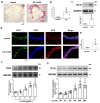Itchy E3 Ubiquitin Ligase-Mediated Ubiquitination of Ferritin Light Chain Contributes to Endothelial Ferroptosis in Atherosclerosis
- PMID: 39769287
- PMCID: PMC11677933
- DOI: 10.3390/ijms252413524
Itchy E3 Ubiquitin Ligase-Mediated Ubiquitination of Ferritin Light Chain Contributes to Endothelial Ferroptosis in Atherosclerosis
Abstract
This research seeks to investigate the function and fundamental mechanisms of Itchy E3 ubiquitin ligase (ITCH), a HECT (homologous to E6AP carboxyl terminus)-type E3 ubiquitin ligase, in endothelial ferroptosis, particularly in the context of atherosclerosis, which has been underexplored. The levels of ITCH protein in the aortas of mice with atherosclerosis were analyzed. Constructs for ITCH RNA interference were generated and introduced into human aortic endothelial cells (HAECs). The findings indicated that ITCH protein expression was elevated in atherosclerotic mice and HAECs exposed to oxidized low-density lipoprotein (ox-LDL). ITCH downregulation significantly mitigated ox-LDL-induced endothelial injury and dysfunction. Reducing ITCH expression inhibited ox-LDL-induced endothelial ferroptosis. This study also revealed that ITCH mediates ox-LDL-induced ubiquitin-dependent degradation of ferritin light chain (FTL) in HAECs. The protective impact of ITCH knockdown against ox-LDL-induced ferroptosis and endothelial injury was reversed by FTL siRNA. Additionally, in vivo experiments showed that inhibiting ITCH reduced atherosclerosis progression and reversed ferroptosis in the aorta, with an associated increase in FTL protein expression in the aortas of mice. This study demonstrates that ITCH interacts with and regulates the stability of the FTL protein via the ubiquitin-proteasome system, contributing to ox-LDL-induced ferroptosis and endothelial cell dysfunction. Targeting components of the ITCH-FTL pathway holds potential as a therapeutic strategy against atherosclerosis.
Keywords: ITCH; atherosclerosis; endothelial cells; ferritin light chain; ferroptosis.
Conflict of interest statement
The authors declare no conflicts of interest. The funders had no role in the design of this study, in the collection, analysis, or interpretation of data, in the writing of the manuscript, or in the decision to publish the results.
Figures








Similar articles
-
Long Non-Coding RNA Nuclear-Enriched Abundant Transcript 1 (NEAT1) Facilitates Foam Cell Formation and Atherosclerosis Progression Through the miR-17-5p/Itchy E3 Ubiquitin Protein Ligase (ITCH)/Liver Kinase B1 (LKB1) Axis.Circ J. 2024 Sep 25;88(10):1697-1708. doi: 10.1253/circj.CJ-23-0769. Epub 2024 Apr 16. Circ J. 2024. PMID: 38631864
-
Oxidized low density lipoprotein induces endothelial-to-mesenchymal transition by stabilizing Snail in human aortic endothelial cells.Biomed Pharmacother. 2018 Oct;106:1720-1726. doi: 10.1016/j.biopha.2018.07.122. Epub 2018 Jul 30. Biomed Pharmacother. 2018. PMID: 30119247
-
UHRF1 inhibition mitigates vascular endothelial cell injury and ameliorates atherosclerosis in mice via regulating the SMAD7/YAP1 axis.Mol Immunol. 2024 Jun;170:119-130. doi: 10.1016/j.molimm.2024.04.001. Epub 2024 Apr 23. Mol Immunol. 2024. PMID: 38657333
-
The E3 ligase Itch in immune regulation and beyond.Immunol Rev. 2015 Jul;266(1):6-26. doi: 10.1111/imr.12301. Immunol Rev. 2015. PMID: 26085204 Review.
-
Itch: a HECT-type E3 ligase regulating immunity, skin and cancer.Cell Death Differ. 2008 Jul;15(7):1103-12. doi: 10.1038/cdd.2008.60. Cell Death Differ. 2008. PMID: 18552861 Review.
References
MeSH terms
Substances
Grants and funding
LinkOut - more resources
Full Text Sources
Medical
Research Materials
Miscellaneous

